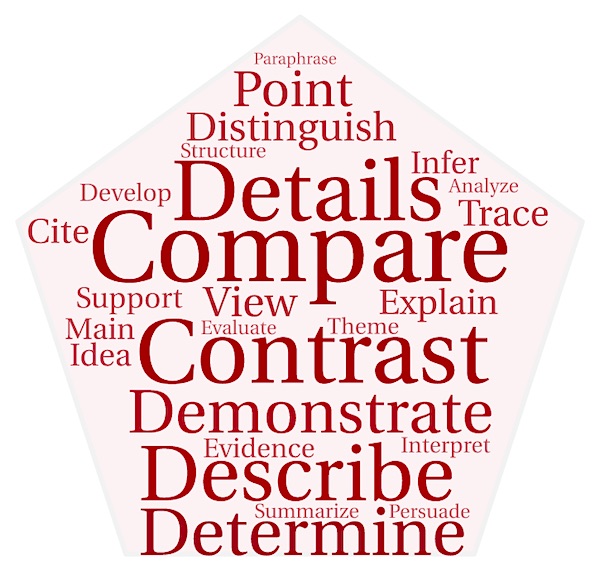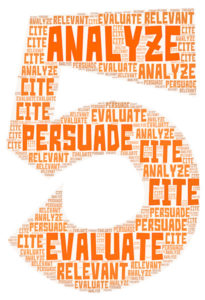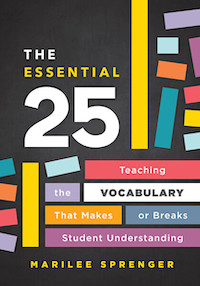25 Words That Trigger Student Understanding
They’re not exciting or glamorous, yet 25 powerful vocabulary words can make or break higher level learning.
The Essential 25. They are not descriptive, alluring adjectives or adverbs that spice up our writing or storytelling. They are the words that higher cognitive function relies on and which encourage creativity.
Words are powerful. They are the tools to understand the language of others, express ourselves, and unlock the mysteries of text and dialogue, plus they literally change the brain!
I have chosen the 25 most high-frequency words for learners in the English language to focus upon. They are found most often on standardized assessments, in state standards, and in college and career settings. I call these words “essential” because knowing and using them can boost academic success and lifelong learning.
Tackling the academic vocabulary of state standards and assessments may seem daunting, but once students get the information into their long-term memory and are able to retrieve it, they are on their way to achieving a deeper understanding of text, improving their writing skills, and using more sophisticated speech.
What are the 25 words?
I divide the Essential 25 into three lists of words that I call:
- the Foundational 11
- the Necessary 9, and
- the Ultimate 5
These are the words – the processes – that change thinking, challenge our beliefs, and enhance writing and dialog. What does it take to know these words? Knowing means storing them in long-term memory, having the ability to access them instantly and act upon them, and allowing available space in our working memory to apply the word while holding onto prior knowledge and new information that are provided in a text or on an assessment.

Having the ability to see various points of view, analyze a text, support work with evidence, and evaluate one’s own work and the work of others are just a few examples of what our students must be able to do. These words provide the avenue to these higher level thinking processes.
► The Foundational 11 are just that – a foundation for understanding and thriving in the world of words. This first list includes compare, contrast, demonstrate, describe, details, determine, distinguish, explain, point of view, support, and trace. The words are found literally everywhere, and we assume that our students know them (yes, they recognize them) and know what to do with them (unfortunately that is not always the case).
► The words in list two, the Necessary 9, are develop, evidence, infer, interpret, main idea, structure, summarize, paraphrase, and theme.
► Finally, the words in list 3, the Ultimate 5, are analyze, cite, evaluate, persuade, and relevant.
We teach these words to ensure strong memory and connections that last beyond middle school, beyond high school, and into life itself. This is the language of academia, and yet, it is also the language of living.
The average student learns about 3000 words each year on their own. Add another 300 words that the experts tell us we should explicitly teach in class in a year’s time, and you give your students an impressive vocabulary gain.
When we choose words that are worthy of our limited time, we find that they are almost exclusively Tier 2 words. These are academic words that are not usually defined in a text or glossary. I call these “forever” words as they keep coming up in school, on assessments, and in life.
The essential 25 words I’ve shared above provide you a priority teaching list to put at the top of your group of words for vocabulary instruction.

How do we teach the Essential 25?
If these twenty-five are the “what,” let’s take a moment to focus on the “how.” How do we get these essential words into our students’ brains so they may use them with ease and purpose? Educational neuroscience suggests these research-based tips:
1. The best way to teach a word is to use it.
If you and your colleagues use these words regularly in your classrooms, as the students become more and more familiar with them, you will hear them in use in their conversations and see them in their writing.
Examples:
-
- “How would you compare this approach to summarizing the story with the approach we used yesterday?”
- “Who can distinguish a pattern in this text structure?”
- “You have drawn an interesting conclusion. Can you support it with evidence from the text?”
- “Please raise your hands for lunch, so I can determine how many meals to order.”
2. We remember best what we act out.
This includes putting movement and action to words and their definitions, role-playing, charades, etc.
Example:
For the word support, have students form groups of three. Two students hold up the third as though their classmate cannot walk.
3. Emotions help us deepen learning.
Helping students see these words on a more emotional level will increase the likelihood of storing them in long-term memory. I suggest personifying the words to help students see the words come to life. Each word has its own story, and then I share a “teacher” story which may be mine or one that another teacher shared. Finally, I ask students to write their own story in relation to the word. Storytelling releases powerful chemicals in the brain that enhance memory.
Examples:
Contrast tells its story: Unlike compare, I see only differences. Those differences aren’t necessarily negative; they can be positive, like “It’s cooler in here than it is outside, but I really like the smell of the flowers outside.” Or “In the Cubs vs. Cardinals game, the Cards won because they have the best players with the most experience.”
A teacher’s story for the word determine: To quote the Lovin’ Spoonful, “Did you ever have to make up your mind?” If I had been Cinderella, who was very determined to get to the ball, I probably wouldn’t have been able to determine whether going to the ball was the right thing to do! I can certainly determine what content I need to teach to my class and what time curfew is for my children. But sometimes I have trouble determining whether to buy a sweater or what to make for dinner!
4. Visualizing vocabulary helps us remember.
A particularly important component of learning vocabulary is visualization. Even middle schoolers and high schoolers like to draw. Creating visuals for the words is a powerful way to remember them. They can draw by hand or using digital tools.
Example:
Ask students to draw a picture comparing or contrasting two people, ideas, or things, such as
-
- Coke and Pepsi.
- The moon and the sun.
- Two characters from a story or novel.
- Feeling sad versus feeling lonely.
- Being a kid versus being an adult.
- Math word problems vs. just using numbers.
5. Retrieval practice pulls knowledge out.
Activities that push us to recall information can help pull our knowledge out and let us examine what we know. Retrieval practice has been shown to increase retention of vocabulary and other content.
Examples:
-
- Practice tests
- Blank page retrieval (have students write down everything they know about a word on a plain sheet of paper)
- Put slips of paper with vocabulary words you want to review in a bowl or bag. Have a student pick a slip of paper and describe what is written on it to the class without using any words from the paper. It must be a verbal description, although movement and gestures are allowed. The person who guesses it correctly is next to take a turn.
25 essential words that empower kids

Although I have grouped these words in a way to indicate an order to teaching them, they can be taught in any order. Since some words build upon others, I created the lists to provide some possible stepping stones. But I would never hesitate to teach a word that the students come across at any grade level or at any time of the school year.
These 25 foundational, necessary and “ultimate” words are critical to our students’ success, and I strongly encourage you to put them at the top of your vocabulary lists!
Marilee Sprenger is an international educational consultant in the fields of social-emotional learning, literacy, vocabulary, and brain research. Marilee was a classroom teacher for 25 years, mainly at the middle school level. In 1992 she trained and traveled with author and brain-based learning educator Eric Jensen and discovered her love for the brain.




































